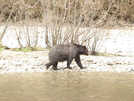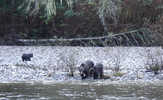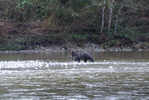

These awe inspiring predators are one of the largest and most powerful land carnivores in the world. They are a subspecies of the brown bear and are thought to have crossed over to North America from Northern Europe about 100,000 years ago but remained in the north of the continent until about 13,000 years ago. They are also known as the silvertip bear or North American brown bear. They gained the title ‘Grizzly’ not as many think because of any aggressive nature but due to grizzled fur which comes in a variety of colours from dark brown to almost blonde with almost white tips. The naturalist George Ord named the bear in 1815 and misunderstand the name giving its Latin title of ‘horribilis’
Go To Grizzly Bear Photo Gallery
 Size varies depending on habitat with the Grizzlies of Canada often growing larger than their US cousins thanks to access to fat rich Salmon during the salmon spawning runs. Females weigh in-between 150-350kg with males being much bigger reaching as heavy as 450kg (1000lbs), when standing on their rear legs they can reach 8ft tall. Despite this size and bulk they can be surprisingly fast able to reach speeds of 35mph (55 km/hr) and are able to climb although few trees can hold their impressive weight. One way to tell them from Black bears is by the muscular hump on their shoulders which gives them great strength for digging and short bursts of speed to bring prey down. They are very capable swimmers and have been seen swimming out to islands and across deep channels in British Columbia.
Size varies depending on habitat with the Grizzlies of Canada often growing larger than their US cousins thanks to access to fat rich Salmon during the salmon spawning runs. Females weigh in-between 150-350kg with males being much bigger reaching as heavy as 450kg (1000lbs), when standing on their rear legs they can reach 8ft tall. Despite this size and bulk they can be surprisingly fast able to reach speeds of 35mph (55 km/hr) and are able to climb although few trees can hold their impressive weight. One way to tell them from Black bears is by the muscular hump on their shoulders which gives them great strength for digging and short bursts of speed to bring prey down. They are very capable swimmers and have been seen swimming out to islands and across deep channels in British Columbia.
 They are normally loners but will gather in uneasy groups at certain times of year to access food. This happens during the salmon run when the salmon return to spawn in huge numbers. The bears will then tolerate each other so they can access the plentiful food source but females with cubs are still very wary of large males who have been known to kill a female to eat her cubs as food starts to run out. Brown bears have been known to live up to 30 years but in the wild natural life span is around 20-25 years depending on food supply and predation.
They are normally loners but will gather in uneasy groups at certain times of year to access food. This happens during the salmon run when the salmon return to spawn in huge numbers. The bears will then tolerate each other so they can access the plentiful food source but females with cubs are still very wary of large males who have been known to kill a female to eat her cubs as food starts to run out. Brown bears have been known to live up to 30 years but in the wild natural life span is around 20-25 years depending on food supply and predation.
The bears have one of the lowest reproductive rates of any land mammal which makes them particularly vulnerable to changes in habitat. Females produce a small litter normally only one or two tiny cubs which begin life being only 500grams. The females are adapted well to ensure the best chance of survival for their off spring being able to delay implantation of the embryo fro months after mating so that the embryo gets implanted just before hibernation. The female's body also miscarries if the female has not gained enough weight prior to hibernation due to lack of available food. Females are very protective of their cubs and at this stage can be very dangerous to humans especially if the humans surprise the mother. She will care for the cubs for two years during which time she will not mate again which is thought to be a reason why males sometimes kill cubs. Even when the cubs have left or been killed a female may choose not to breed for several years. Sibling and mother groups are the only time apart from the salmon run where the bears are seen in groups although older female cubs returning to forage with their mother has also been observed. Male bears can control a territory of up to 4,000 sq km so seeking out a female by scent over such a large area can be difficult. As winter approaches the bears seek to gain weight and if food is plentiful they can gain up to 400lbs. The bears then enter a state of false hibernation (some argue that the bears never truly hibernate as they can move about during this period and their body temperature remains too high) normally triggered by a change in the weather such as a snow storm to mask the bear entering a den as during this time they are vulnerable and bears have been know to seek out and kill other hibernating bears while they are in this sleepy state. A Den is normally high up often above 6,000ft and frequently faces north. Grizzlies can also partially recycle body waste during this period.
The Grizzly bear evolved from the Brown bear which is found in Asia and Europe making Brown bears the most widely spread of any of the bear species still alive today. This evolution happened only 50,000 years ago making the Grizzly very similar to its Europe and Asian cousins. The North American the bears once had a huge range from Alaska to Mexico and across much further east than their current range. In the present day the remaining 55,000 bears are found in Alaska, much of Western Canada (where the photo’s shown here were taken) and some areas of the US North West as far south as Yellowstone national park, with the bulk of the population being in the Canadian Rain forests(link here to article already on site). Canada is home to an estimated 16,000 animals spread across British Columbia , Alberta , The Yukon, The Northwest territories, Northern Manitoba and Nunavut. Canada has seen the least reduction in the bears range with them still occupying what is thought to be 90% of the original range.
Grizzly bears are vital to the eco systems of the temperate rainforests. Grizzlies will consume huge amounts of berries helping to disperse the seeds along with a handy parcel of nutrients for them to germinate in. In the nutrient poor soils of the British Columbian Rain forests the bears digging for food and carrying salmon carcasses back into forests has a huge impact on adding nitrogen to the soil. This has such an effect that the numbers of salmon on a salmon run and hence the number eaten by bears can actually be seen recorded in the size of the growth rings in the forest trees. Nitrogen from Salmon has been found in the foliage of Spruce trees more than 1,600ft from the nearest stream
Grizzlies have evolved with a carnivore digestive system but they are much closer to omnivores and when prey is hard to find can subsist almost purely on vegetation (up to 90% of their diet). A fast ambush predator they have been known to take moose, deer, sheep, elk caribou and bison as well as not being averse to killing and eating other bears such as Black bears and at times young or smaller grizzlies. During the Salmon run the bears will gorge themselves on vast quantities of protein rich Salmon which allows coastal bears to grow much larger than those living in the interior especially those in Yellowstone where much of their diet can be made up of pine nuts, roots and tubers as well as small rodents. When food is plentiful as during the salmon runs the bears will gather together, when food is scarcer they are much more solitary. They will also take carrion and clashes between them and grey wolves have been seen where the bear has picked up the scent of a wolf pack kill and tries to take the kill from the wolves. The bear has the advantage in size and strength but the wolves have numbers so this can go either way, neither animal is normally seriously hurt.
 Black bears and Grizzlies rarely co exist due to competition although the Grizzlies tend to prefer more open older forests than the smaller Black bears who will avoid the bigger brown bears for fear of being killed and eaten. Cougars tend to avoid Grizzlies and will abandon kills if challenged by a bear, smaller predators such as foxes and wolverines are not direct competition for the Grizzlies although wolverines are determined enough to finish off kills left by the bear
Black bears and Grizzlies rarely co exist due to competition although the Grizzlies tend to prefer more open older forests than the smaller Black bears who will avoid the bigger brown bears for fear of being killed and eaten. Cougars tend to avoid Grizzlies and will abandon kills if challenged by a bear, smaller predators such as foxes and wolverines are not direct competition for the Grizzlies although wolverines are determined enough to finish off kills left by the bear
Human interaction
Some consider Grizzlies to be one of the most aggressive bear species but any attack on humans is normally provoked by a poor understanding of the bear or inappropriate human behaviour. As Grizzlies are too big to climb trees to escape a threat they will often stand their ground if taken by surprise, which is many of the experienced wilderness guides working with the bears make sure the bears know they are about by calling ‘Hey bear’ so they don’t startle the bear. Females with cubs can be dangerous and are responsible for 70% of fatal attacks on humans. Bears make a chuffing sound when they feel threatened this can sound like the animal coughing loudly and is a good indication for you to leave the area. This can be very unnerving when you can hear the chuffing but cant yet see the bear! Most bears will avoid humans when possible and will try to avoid eye contact with humans when they are aware of you, and it is very rare (but not unheard of) for a bear to hunt humans as prey.
Humans hunting for sport can place themselves at risk whether this be anglers fishing for salmon or hunters shooting game where the gunshots actually attract the bears who have learned to associate the sound with fresh kills which they can then steal. Poor camp discipline or people foolishly feeding bears can be fatal for a bear as they learn to associate people with food leading them to become ‘problem’ bears. These bears are sometimes relocated but may have to be shot.
You should maintain good camp discipline if camping in bear country, even oil from food cooked outside can attract a bear, even lip balm has been know to attract them and they are quite capable of ripping open cars and vehicles to get to food. Hanging food in trees out of reach can help but the bears are good problem solvers and can often find ways to get to food. Some people use bear canisters to solve this. Travelling in a group of six or more also improves safety while walking or hiking in bear country as this means more noise so the bear is less likely to be taken by surprise (some groups sing or whistle) but also if the bear spots a larger group it is more likely to move away rather than stand its ground or attack.
All the photos seen here were taken by the author while staying at Great Bear Lodge in British Columbia. This is highly recommended as the guides/ owners are highly experienced and respectful of the bears and will give you a fascinating insight to these magnificent animals
Great Bear Lodge, British Columbia